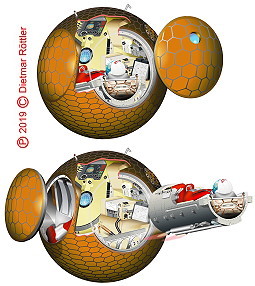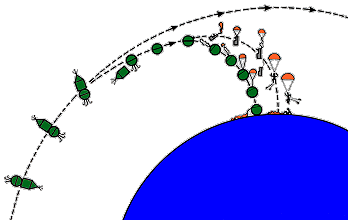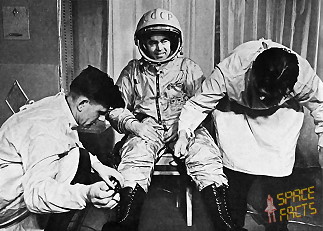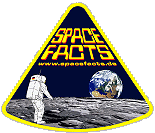Launch from the Baikonur Cosmodrome and
landing 200 km southeast of Karaganda.
This mission was a
rendezvous
flight with Vostok 4. Both
spacecrafts came close to 6.5 km (visibility), although the
Vostok capsules had no maneuvering capability. They
quickly drifted apart.
Vostok 3 also conducted several scientific
observations and further improvement of the space ship systems, communications
(spaceship ground control and spaceship to spaceship), guidance and landing.
There were no problems with his spacesuit, but there was only a minor problem
with the Tral telemetry system.
During his first day in orbit,
Andriyan
Nikolayev unstrapped himself from his seat and became the
first spacefarer to float freely in conditions of microgravity in
space
Andriyan
Nikolayev's orbital companion Pavel
Popovich was launched the next day aboard
Vostok 4. Data on the two spacecraft's
orbital parameters that were released periodically by Soviet news agency TASS
seemed to indicate a change in
Vostok 3's orbital trajectory within ten hours of
Vostok 4's launch, leading to
speculation that the former spacecraft modified its orbit to bring it closer to
that of the latter. The
Vostok spacecraft is not believed to have had the
ability to modify its orbit. Plans were for the spacecraft to approach to 5 km
(3.1 mi), but the closest distance achieved was 6.5 km (4.0 mi). At the start
of
Vostok 3's thirty-third orbit this distance had
diverged to 850 km (530 mi), and to 2,850 km (1,770 mi) at the start of the
sixty-fourth.
Andriyan
Nikolayev and Pavel
Popovich made contact with one another via shortwave radio
soon after their spacecraft approached one another; they would maintain regular
ship-to-ship communications over the course of their mission in addition to
their contact with the ground. Andriyan
Nikolayev reported sighting the
Vostok 4 capsule after it entered
orbit near him
Both Andriyan
Nikolayev and Pavel
Popovich spent time out of their seats each day, conducting a
series of tests to determine their ability to maneuver and work in conditions
of weightlessness. Each test was said to last "about one hour". The physical
and mental state of the cosmonauts were monitored: biometric sensors relayed
the cosmonauts vital statistics to the ground; the cosmonauts' behavior and
coordination was observed via a cabin-mounted video camera; and the cosmonauts'
ability to perform various operations in coordination with ground controllers
was considered. The cosmonauts' speech was monitored both by controllers on the
ground and one another. The results of the tests were deemed positive, evidence
of the ability of humans to function and work over longer periods in
microgravity.
A final "first" for
Vostok 3 was Andriyan
Nikolayev's taking of color movie footage of the Earth from
orbit and from the cabin interior.
The reentry was the same procedure
as in the other
Vostok missions.
![]()

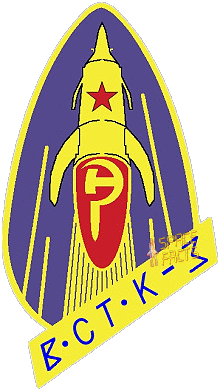
![]()




